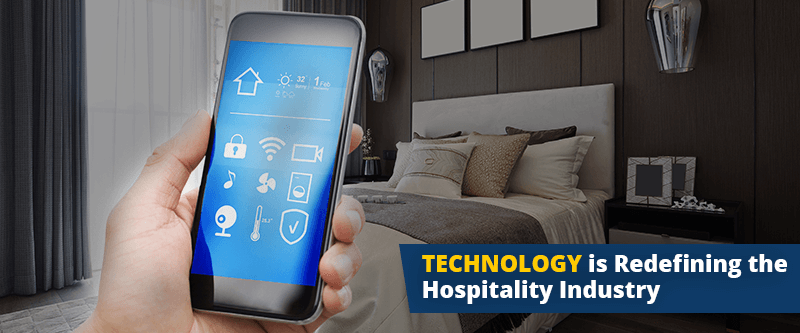“Technology has always fascinated me,” Patrick exclaimed while sipping his third single malt. He was sitting with Jacob and Jonathan in a new pub in NY which offered entry with face recognition instead of manual entry and QR code based menu instead of printed menus. The seasoned hoteliers went on talking about how technology in hospitality industry started as a small neuron to become the backbone of a hotel in every aspect.
“Bringing technology to mobile was the game changer. It is not just about the hoteliers’ ease but also about providing an end to end experience to the guest”, said Patrick the great.
As the crowd started to gather around the table, the showman narrated the tale of hotels and how technology transformed the way people travel today.
Hello, in this blog I have tried to cover how technology is changing the face of the hospitality industry.
Table of Contents
Technology in Hospitality Industry: How Did it Evolve?
Hospitality has existed globally since the time of cavemen. However, commercialisation only came into the picture in the 700s. It was not until the 1800s that the world saw the first modern hotel in England. Colonisation and increased global trade facilitated traders travelling distances. Nonetheless, the only technology available in the most upscale hotels until 1894 was a telephone at the front office which required an operator. Around 1927, radios made their way to the hotel rooms.
Leisure travel was a luxury the rich could afford in the 1900s. Technology was slowly making its way to hotels.
Teledex made the first ever telephones specifically for the hotel industry in 1984; which to date remains one of the most used technologies in hotel rooms.
The personal computer in 1981, followed by the worldwide web in the 1990s was an actual technology revolution that hotels witnessed with people using alternative channels to book their stay.
The front office has always been the first department to embrace any tech related changes in a hotel.
Technology at the Hotel Front Desk
I have maintained for years that the front office is the backbone of any hotel. Essentially so, because guest reservations come under the purview of the front office team.
One may argue that room sales generate revenue and hence it comes under the sales and revenue department.
I would like to clarify to all readers that sales executives make outbound calls, while the reservation team caters to inbound queries.
The Hotel PMS
When technology use in the hospitality industry was still in its infantry stage, people would walk into an accommodation, check availability and book the rooms. Then came the telephonic revolution. The guests and the travel agents would call a hotel and book the room whenever they pleased. Some hoteliers used the rudimentary methods of record keeping with manual data entry on books. Some still continue to do so in the smartphone era.
The smart hotels adapted to technology when dot com was still not heard of. In the 70s, the legacy PMS appeared in the market, which helped the hoteliers keep a track of reservations and inventory; a module based on the airline’s model.
With the front office’s role increasing in the hotel operations, these systems kept on upgrading themselves with modules like guest profiling, housekeeping, GDS connectivity, sales and profits, revenue management; one at a time. This was indeed a costly affair. Hoteliers were required to purchase a new system to match the software, and needed technicians to upgrade the software. Until 2010, the PMS systems were offline and off the cloud.
The year 2010 has been another celebration worthy milestone for the hoteliers. SaaS companies took the legacy software to the cloud. This has since eliminated the need for on-premise installations and configurations; apart from tangible benefits like the ability to operate the software from any device, data security and freedom from the bandwidth issue. The potential of the cloud PMS systems to integrate with third party software has streamlined operations like accounting, concierge, housekeeping, payment management, etc.
After 2017, the trend for API first has been established in PMSes, enabling third party integrations without having to redesign the entire software.
OTAs and the Channel Managers
If you belong to the Boomer, Gen X or Millennial era and were lucky enough to have dial-up, you’d know what and how websites looked back in the 90s.
In the year 1995, chain hotels realised the power of data centralisation and online bookings. This idea paved the way for companies like Booking.com, Travelocity, and Expedia in 1996.
Until then, GDS systems were the only form of online bookings where agents would log in to the system via intranet on guests’ behalf to book hotels, airline tickets etc.
Indian entrepreneurs too ventured into the travel dot com business in the 2000s giving birth to MakeMyTrip, TravelGuru, Cleartrip, Goibibo and so on.
People started exploring these websites for flight and hotel bookings. They were fixated to travel guides and looked up hotels on the internet when there was no direct contact number. Travellers diverted from traditional agents to online travel aggregators which offered a variety of hotels, funnels, centralised information and attractive prices. It was a win-win for both the hotel and OTAs as the hotels were able to reach out to more guests and the OTAs were earning commissions in return.
Necessity is the mother of invention.
With a rise in the number of online channels, a need for middleware was felt which could send rate and inventory to all the OTAs simultaneously and report the bookings to PMS. Thus the channel manager was born.
Hoteliers embraced the new tech dearly as it reduced the manual efforts of pushing rates and inventory separately on every OTA. The overbookings substantially decreased as the channel manager updated the data across all the OTAs in real time. Eventually, channel manager has become a full-fledged software that works independently of a PMS system. Modern day channel managers control aspects like analytics, discounts, review management from within the wireframe.
The Revolution of Mobile Technology in Hospitality Industry
Another technology that was making its way to users at the beginning of the 21st century was mobile phones. In the year 2007, late Steve Job’s Apple Inc. launched the first iPhone; and the world has never been the same ever since. Other hardware makers followed the suit. Google quickly launched its Android OS for mobile phones.
Between 2010 and 2015, the number of mobile users and mobile usage increased multifold globally. OTAs too seized the opportunity and started rolling out their websites in the form of mobile apps. Avid travellers moved to mobile apps while the traditional ones needed the motivation to move.
Mobile discounts started making their way.
Hoteliers were now able to get better visibility for a nominal extra price.
As of today, 70% of the total hotel research and bookings happen through mobile where Gen Z is leading the march.
Mobile has also enabled travellers to make a last-minute plan. Gone are those days where the local travel bookings also happened 15-20 days in advance. Google data shows that travel related searches including ‘tonight’ and ‘today’ have increased by 519% over the last five years.
However, that being said, the conversion ratio of people checking a property on mobile v/s people booking that property is merely 21%.
This means the hoteliers have to be on the top of their game in terms of the content, offerings, and services to be bookable.
The top 5 usages of cell phones while travelling among Indians
Source: Hindustan times
- To book a hotel room (73%)
- Maps to get around (61%)
- Comparing prices and deals (60%)
- To book a flight (59%)
- To book a cab ride (58%)
The technology used in the hotel industry has reached beyond hotel bookings now. Companies are investing to invent and offer an end to end tech experience to travellers. The post COVID era has seen a rise of solutions like contactless check-ins, mobile app-based room service, face recognition based room door unlocking and much more.
Hilton went a step ahead and developed Connie, the world’s first concierge robot in 2016 based on AI and ML in collaboration with IBM.
Technology in hospitality industry has restructured the guest reservations completely. Automated payment reminders, important details to know before arrival are now pre-configured in the PMS, saving time and efforts to pass on the same details. The chatbots answer many guest queries after office hours, increasing guest satisfaction.
Revenue and sales departments have immensely benefitted from technology used in hotels. It empowers them to perform a multi-dimensional data analysis in order to set up the rates for future dates. The rise of dynamic pricing tools has reduced the work of revenue managers by 80%.
Data analysts are now entering the hotel industry to change the way hotels set their tariffs.
Tech has penetrated deeply into the other aspects of hospitality as well.
Technology in Hospitality Industry Beyond the Front Office
While the front office has aced the technology game, other departments are not left far behind. The restaurants use POS systems to record orders, generate KOTs and invoices, collect payments and even do stock management. The tablets in the hands of the servers have replaced traditional KOT books, which resulted in missing out on an order or preparing the wrong dish. These days orders are displayed widely on the kitchen TV screens (KDS) for the chefs to act upon.
That is not all; robot servers, drone food delivery, driverless car delivering food are also outstanding examples of technology changing the face of hospitality.
Though housekeeping is a manual job, modern day housekeepers have made their own cool devices to improve their efficiency. One such device is a housekeeping robot that cleans the floor efficiently while the housekeeping staff takes care of other chores.
Even the ever centurion looking accounts department has moved to use internet based solutions to be able to work from anywhere and have all reports at the fingertips.
Every hotelier is now giving utmost importance to the safety and security of their guests and staff. The hotels these days are powered with night vision cameras, remote visual IP based cameras, unbreakable safety lockers and sensor based alarms among other things to provide their guests with a sense of security.
Takeaways
- Technology has changed the way hoteliers provide and end-users receive the experience.
- With time, technology has become as important as data.
- Mobile apps for the hotel industry are the next big thing, and they are going to stay.
- Hotels that do not adapt to technology will peril.
What’s Next for Technology in the Hospitality Industry?
So far, we explored and understood how technology in the hospitality industry evolved. However, it is equally important to be aware of what’s in store in the upcoming years.
IoT in Hospitality Industry
IoT or the Internet of Things is going to be the next big change in hotel tech. It is already revolutionising the US and UK markets with devices like self-serving kiosks, smart lighting, temperature control on pre-defined instructions.
Well, that is just the tip of the iceberg. IoT can do many more amazing things. We have a dedicated article on IoT for hotels which you can read here.
Besides IoT, the new technology used in the hospitality industry would be blockchain, artificial intelligence and OCR.
In Conclusion
With each passing day, the technology reinvents to improve our efficiency and save time to get some more work done.
From video CDs of the hotels to 360 degree photography, soon, we will get the 3D look and feel of the property through AR. Some hotels have already pioneered VR based hotel tours.
The important thing to remember is to be humane and consume the technology instead of being consumed by it.



